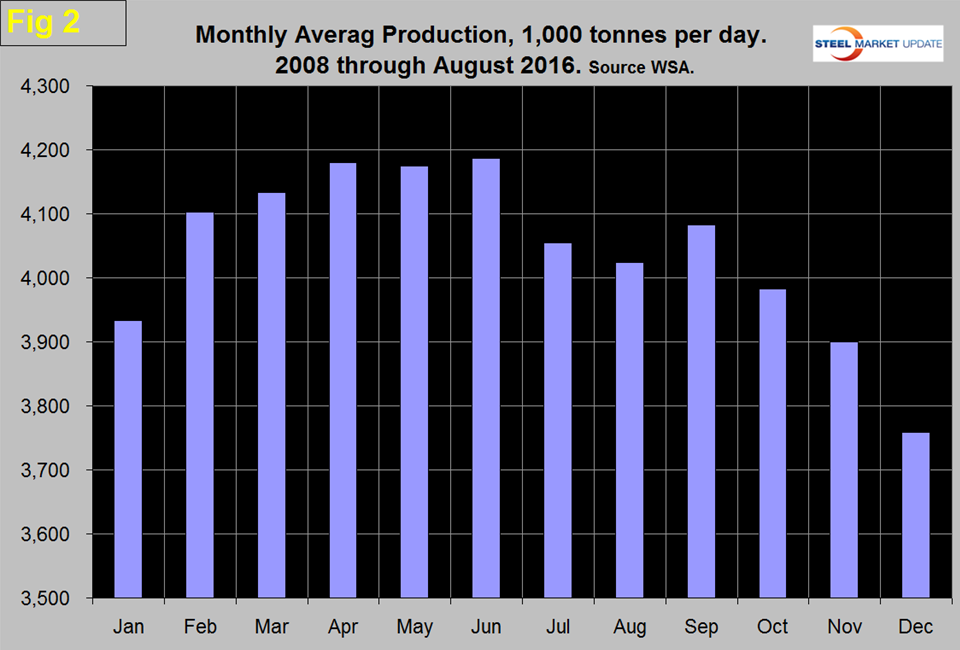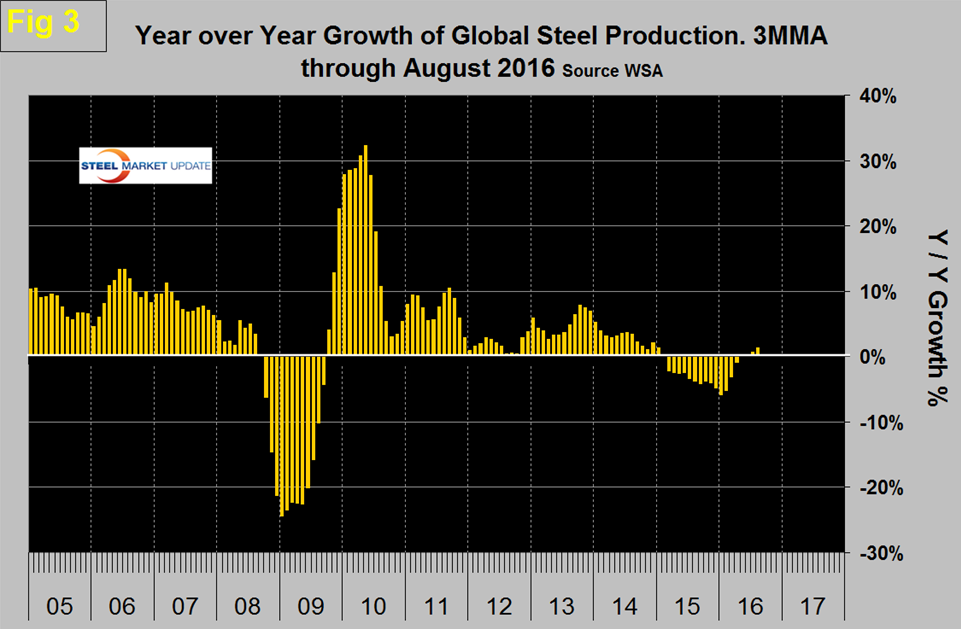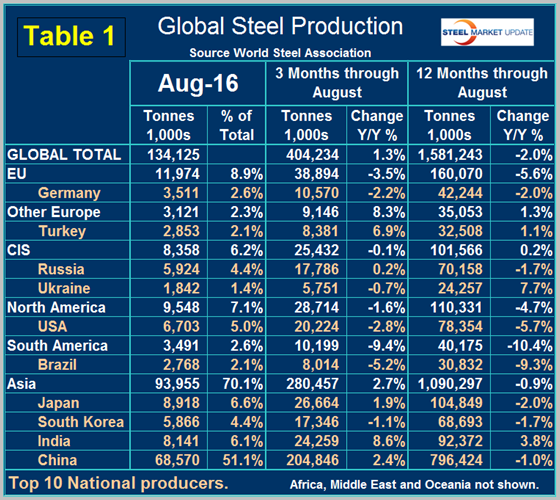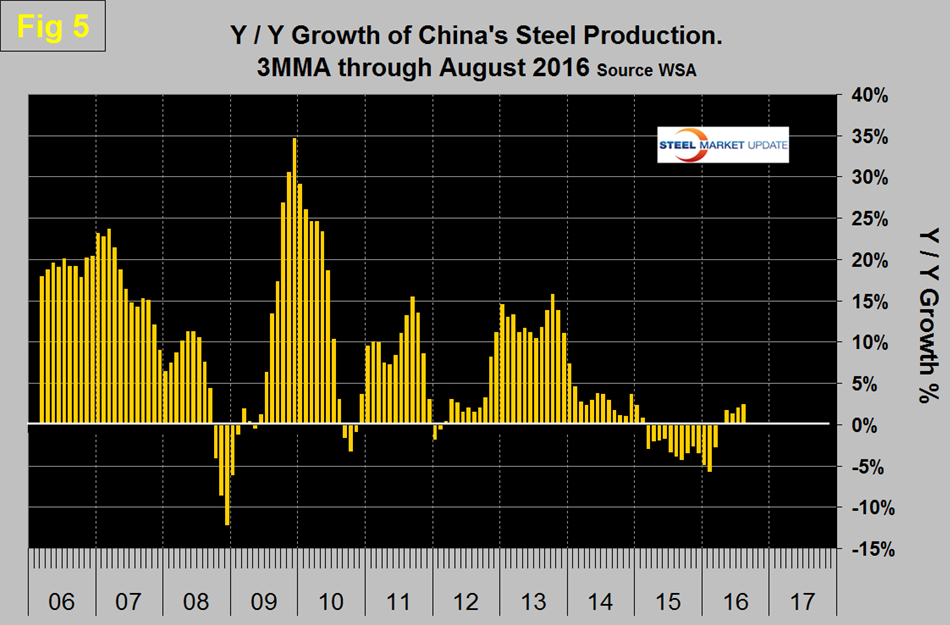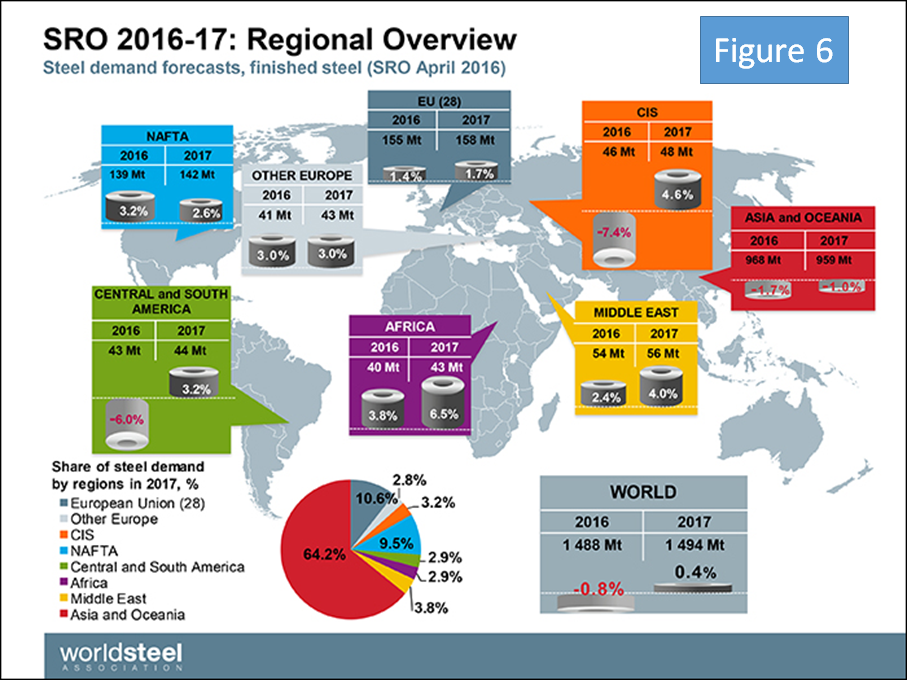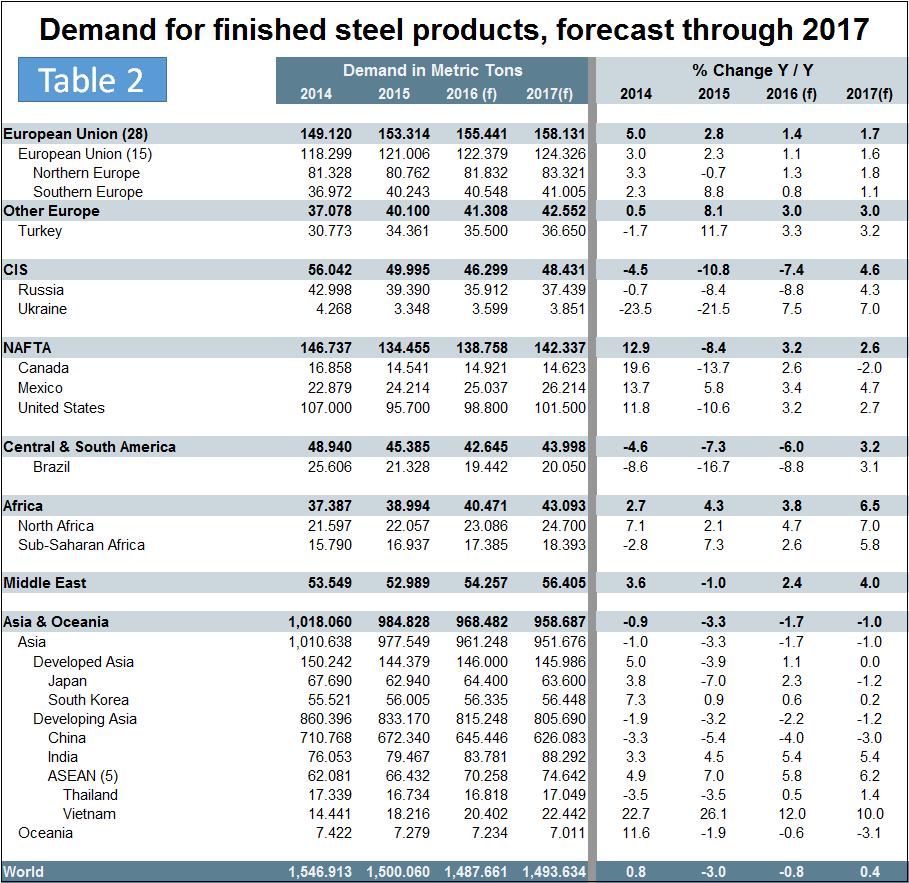Steel Products Prices North America

Global Steel Production in August and Forecast through 2017
Written by Peter Wright
September 26, 2016
Production in the month of August at 134,125,000 metric tons was up by 0.2 percent from July and the three month moving average (3MMA), that we prefer as a measure, was down by 0.13 from July. Capacity is 2.35 billion tonnes per year and the 3MMA of capacity utilization in August was 68.8 percent. Figure 1 shows monthly production and capacity utilization since January 2000.
On a tons per day basis, production in August was 4.327 million tonnes, up by 0.2 percent from July. Since the recession, capacity utilization has been on a steadily downward trajectory with an upward blip in the first few months of 2016. Capacity utilization in the three months through August at 68.8 percent was down from 70.0 percent in three months through August last year. More bad news is that year over year the 3MMA of production was up by 1.3 percent and the momentum of production has increased for seven consecutive months. On September 9th the OECD’s steel committee reported that global capacity is expected to increase by almost 58 million tonnes per year between 2016 and 2018 bringing the total to 2.43 billion tonnes.
As we dig deeper into what is going on, we start with seasonality. Global production has peaked in the summer for the last seven years including 2016. Figure 2 shows the average monthly production by month since 2008.
In those 11 years on average, August has decreased by 0.75 percent; this year August was up by 0.2 percent. We can expect September to have about a 1.5 percent increase, if history is a guide, and then look for a continuous decline through December. We believe it’s necessary to look at the year over year change in the three month moving average to eliminate seasonality and, on this basis, August was disappointing in that production increased. Figure 3 shows the change in growth rate since January 2005.
Production began to contract in March last year and the contraction accelerated through January this year when it reached 5.8 percent. In the next four months contraction slowed and in May was zero. June, July and August have had year over year increases in the 3MMA of 0.1 percent, 0.7 percent and 1.3 percent. The much desired slowdown in global steel production has reversed course on a year over year basis and China has been the driver.
Table 1 shows global production broken down into regions and also the production of the top ten nations in the single month of August and their share of the global total. It also shows the latest three months and twelve months production through August with year over year growth rates for each period.
Regions are shown in white font and individual nations in beige. The world as a whole had positive growth of 1.3 percent in 3 months and negative 2.0 percent in 12 months through August. If the three month growth rate exceeds the twelve month, we interpret this to be a sign of positive momentum which has been the case for the last seven months.
Figure 4 shows China’s production since 2005 and Figure 5 shows the year over year growth.
China’s production, after slowing for 13 straight months on a 3MMA basis year over year, returned to positive growth in May, June, July and August and accounted for 51.1 percent of global production in August. The slowdown in Chinese steel production that the rest of the world has demanded is NOT happening. We reported in our last three updates and will repeat here that in March, China’s assistant commerce minister stated that “China had cut 90M metric tons of capacity and had plans to reduce it by another 100M-150M.” Our response is that reducing capacity is not the same thing as reducing production and there is no sign that the reported capacity reduction (if it is for real) is having any effect on output. To put this into perspective with the rest of the world, on a 3MMA basis year over year through August, China had 2.4 percent growth while the rest of the world grew by 0.1 percent.
On a regional basis in 3 months through August year over year, South America and the EU declined by 9.4 percent and 3.5 percent, respectively. Asia as a whole was up by 2.7 percent with India up by 8.6 percent. Other Europe (mainly Turkey), was up by 8.3 percent and North America was down by 1.6 percent. Within North America, the US was down by 2.8 percent, Canada was down by 0.2 percent and Mexico up by 7.0 percent.
The October 2015 version of the World Steel Association Short Range Outlook (SRO) for apparent steel consumption in 2015 and 2016 had last year contracting at 1.7 percent and 2016 growing at 0.7 percent. What actually happened was that consumption contracted by 3.2 percent in 2015. In April this year the WSA updated its forecast. (Note this forecast is steel consumption, not crude steel production which is the main thrust of what you are reading now.) Figure 6 is a geographical view of production and growth in 2016 followed by Table 2 which shows the expectations by country and region.
We will leave these two figures in our monthly updates for reference until they are revised in October. The current WSA forecast has global demand in 2016 contracting at 0.8 percent and in 2017 growing at 0.4 percent. Based on this forecast, NAFTA will grow by 3.2 percent this year and 2.6 percent next. China’s demand will decline by 4.0 percent this year and 3.0 percent in 2017. Therefore, if their production doesn’t decline by at least that amount the flood of exports will only increase.
SMU Comment: Evidently China is picking up the pace again as the rest of the world has contracted for 18 straight months through July and experienced a slight positive 0.1 percent growth in August. With a global capacity utilization of less than 69 percent in July and August it is evident that capacity reductions have a long way to go before they begin to reduce the market pressure of over production. According to the OECD, capacity will continue to increase through 2018. To make matters worse, global economic growth is slowing as we will report next month when the new report and forecast of global GDP will be released by the IMF. We repeat what we have said before and still believe, that oversupply and low capacity utilization won’t be resolved before the end of this decade and probably well into the next.
Source World Steel Association with analysis by SMU.

Peter Wright
Read more from Peter WrightLatest in Steel Products Prices North America

Nucor slows HRC price climb with $5/ton increase
After eight weeks of double-digit price increases on hot-rolled (HR) coil, Nucor slowed the price rise this week with an increase of $5 per short ton.

Domestic CRC prices surge ahead of imports
The price spread between stateside-produced CR and imports reached its widest margin in over a year.

Evraz raises plate prices $160/ton
Evraz North America (NA) has followed Nucor and SSAB with a plate price increase of its own: up $160 per short ton (st). The increase was effective immediately for all new orders of carbon, high-strength low-alloy, and normalized and quenched-and-tempered plate products, as well as for hot-rolled coil, the steelmaker said in a letter to […]

Nucor lifts HR coil to $820/ton
Nucor has increased its consumer spot price (CSP) for hot-rolled (HR) coil for a fourth consecutive week.

Nucor pushes HR spot price to $790/ton
Nucor increased its consumer spot price (CSP) for hot-rolled (HR) coil to $790 per short ton (st) on Monday, Feb. 10 – a $15/st bump vs. last week. The Charlotte, N.C.-based company has raised its weekly CSP by $40/st over the past three weeks after maintaining tags at $750/st since Nov. 12, according to SMU’s […]


